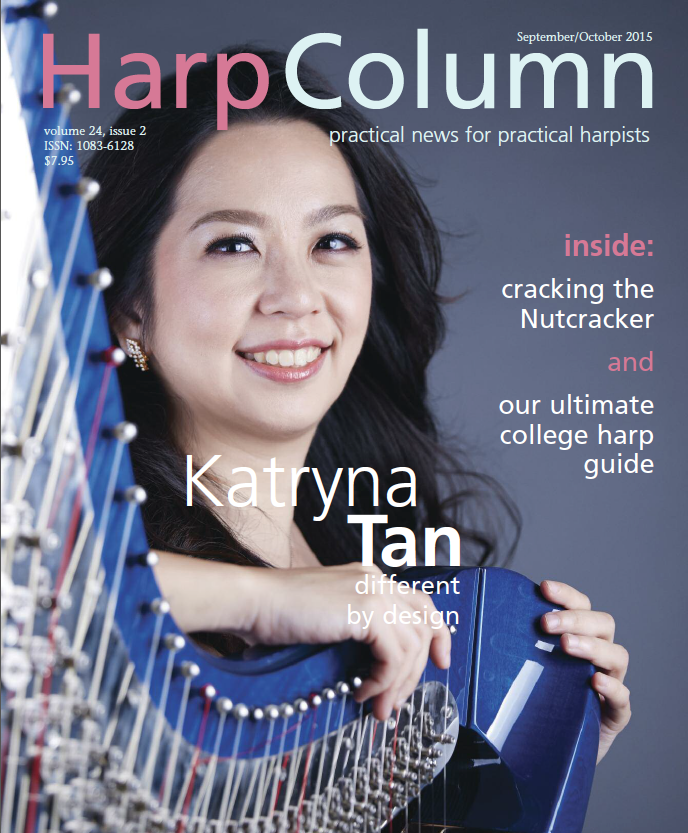Although the leaves may not have begun to change into their fall colors, it’s not too early to start thinking about Christmas music. There are several recent publications worthy of consideration.

Christine Mazza has published three volumes of Christmas Music for Harp Ensemble with four selections in each one.
On the plus side, some of these arrangements are terrific. In Volume I, the medley of “Good King Wenceslaus,” “Ding Dong Merrily on High,” and “The Holly and the Ivy” is very clever and interesting. It’s written for three harps, but you can actually just use two of the parts if you find that it gets a little busy when all three tunes are playing at the same time. Meredith Willson (remember the duets from “The Music Man”?) couldn’t have done it better. “Go Tell it on the Mountain” from Volume II is an outstanding arrangement and a lot of fun to play. It’s a little more challenging rhythmically, and it swings. “Jolly Old St. Nicholas” from Volume III offers several diverse styles with three variations.
On the minus side, lengthy sections of two or even three parts playing in unison are a little too frequent. In these instances, it might have been preferable to make one of the parts a little easier so that it would be more useful for multi-level ensembles.
Ms. Mazza warns “any harpist who duplicates my arrangements shall be severely plucked” on the title page. However, since parts one, two, and sometimes a third part are printed back-to-back and bound together in the same book, you will need to purchase at least two books (or three if you want the occasional part three) to be able to play all the parts. The full score is offered in another book. A trio ensemble should purchase three part books and the score. Although there are some good arguments for printing the music this way, offering separate, pull-out parts might further discourage a trip to the copy machine.
The typesetting is easy to read, fingering is suggested in a few spots, and pedal markings are clearly indicated below the staff. Lever markings are a little less clear, but most parts don’t require many lever changes during the piece. Most of the music is sight-readable for the intermediate player and some, such as “The First Noel” (Vol. II) are easy. The more difficult parts are still sight-readable for advanced players. “Sing We Now of Christmas” (Vol. III) has four parts, although there is a fair amount of duplication in the parts. Nevertheless, these are nice collections overall.

Cindy Horstman (C. Horstman Music) has written a spirited, jazzy, original piece for three harps called “Snow Daze.” Harp I can be played on lever harp and is right hand only except for the final measure, a sixth-octave F that would need to be played an octave higher on lever harps anyway. Harp II plays tremolos for most of the piece except for a short section where they are handed off to Harp III. Harp III plays mostly chords. There are a few pedal changes, but none are difficult and all pedal markings are included.
You can hear an mp3 recording on her website at www.cindyhorstman.com. The tempo is fast and evokes images of snowflakes swirling in a gusty, winter wind. This would make a lively and vibrant addition to a harp ensemble program.

Frank Voltz (Chiera Music) presents the traditional Christmas carol, “We Three Kings” in 4/4 time instead of 6/8 time. However, that isn’t the only thing that adds a new feel to this old tune. He includes some touch damping after chords. These muffled chords tease the listener who is then rewarded with a fully rolled execution of the chord. He includes some glisses and some downward sixteenth note patterns. He has both hands play pres de la table for a few measures and makes the melody finish with a major chord instead of minor. There is a lot of variety packed into this piece, so give it a try!
Catherine Rogers has self-published her arrangement of “Wexford Carol” for solo pedal harp. It is just two pages in length and is printed on separate, cream-colored sheets to make it easy to slip them into a notebook. No fingering is suggested (or needed) and pedal changes are marked in large font below the staff. The left hand plays mostly eighth notes as accompaniment throughout, while the melody is a single note on the first verse and then expanded to include chords on the second. You may be inspired to play the first verse again to make it last a little longer. Intermediate to advanced players can sight-read this music.

This lovely melody may not be in the top ten of the most popular Christmas carols, but Ms. Rogers’ arrangement is a readily playable and charming addition to the holiday repertoire. •







